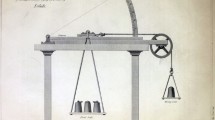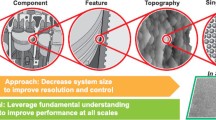Abstract
A correlation is established between the macro-scale friction regimes of metals and a transition between two dominant atomistic mechanisms of deformation. Metals tend to exhibit bi-stable friction behavior—low and converging or high and diverging. These general trends in behavior are shown to be largely explained using a simplified model based on grain size evolution, as a function of contact stress and temperature, and are demonstrated for self-mated pure copper and gold sliding contacts. Specifically, the low-friction regime (where µ < 0.5) is linked to the formation of ultra-nanocrystalline surface films (10–20 nm), driving toward shear accommodation by grain boundary sliding. Above a critical combination of stress and temperature—demonstrated to be a material property—shear accommodation transitions to dislocation dominated plasticity and high friction, with µ > 0.5. We utilize a combination of experimental and computational methods to develop and validate the proposed structure–property relationship. This quantitative framework provides a shift from phenomenological to mechanistic and predictive fundamental understanding of friction for crystalline materials, including engineering alloys.











Similar content being viewed by others
References
Bowden TF, Hughes TP (1938) Friction of clean metals and the influence of surface films. Nature 142:1039–1040
Bowden FP, Tabor D (1939) The area of contact between stationary and between moving surfaces. Proc R Soc Lond A 169:391–413
Bowden FP, Young JE (1951) Friction of clean metals and the influence of adsorbed films. Proc R Soc Lond A 208:311–325
Bowden FP, Tabor D (1964) Friction and lubrication of solids, vol II. Oxford University Press, Oxford
Antler M (1980) Sliding wear of metallic contacts. In: Proceedings of the 26th annual holm conference on electrical contacts, pp. 3–24
Rigney DA, Hirth JP (1979) Plastic deformation and sliding friction of metals. Wear 53:345–370
Burton RA, Russel JA, Ku PM (1962) Metallic friction at cryogenic temperature. Wear 5:60–68. doi:10.1016/0043-1648(62)90181-3
Prasad SV, Battaile CC, Kotula PG (2011) Friction transitions in nanocrystalline nickel. Scr Mater 64:729–732. doi:10.1016/j.scriptamat.2010.12.027
Tamai Y (1961) Friction of metals in reciprocating sliding. J Appl Phys 32:1437. doi:10.1063/1.1728374
Prasad SV, Michael JR, Christenson TR (2003) EBSD studies on wear-induced subsurface regions in LIGA nickel. Scr Mater 48:255–260
Padilla HA, Boyce BL, Battaile CC, Prasad SV (2013) Frictional performance and near-surface evolution of nanocrystalline Ni-Fe as governed by contact stress and sliding velocity. Wear 297:860–871. doi:10.1016/j.wear.2012.10.018
Argibay N, Bares JA, Keith JH et al (2010) Copper-beryllium metal fiber brushes in high current density sliding electrical contacts. Wear 268:1230–1236
Argibay N, Sawyer WG (2012) Low wear metal sliding electrical contacts at high current density. Wear 274–275:229–237. doi:10.1016/j.wear.2011.09.003
Feser T, Stoyanov P, Mohr F, Dienwiebel M (2013) The running-in mechanisms of binary brass studied by in situ topography measurements. Wear 303:465–472. doi:10.1016/j.wear.2013.03.047
Greiner C, Liu Z, Strassberger L, Gumbsch P (2016) Sequence of stages in the microstructure evolution in copper under mild reciprocating tribological loading. ACS Appl Mater Interfaces 8:15809–15819. doi:10.1021/acsami.6b04035
Thompson CV (1990) Grain growth in thin films. Annu Rev Mater Sci 20:245–268. doi:10.1007/s13398-014-0173-7.2
Johnson KL (1985) Contact mechanics. Cambridge University Press, Cambridge
Merwin JE, Johnson KL (1963) An analysis of plastic deformation in rolling contact. Proc Inst Mech Eng 177:676–690. doi:10.1243/PIME_PROC_1963_177_052_02
Antler M (1964) Processes of metal transfer and wear. Wear 7:181–203
Johnson KL (1995) Contact mechanics and the wear of metals. Wear 190:162–170. doi:10.1016/0043-1648(95)06665-9
Rupert TJ, Schuh CA (2010) Sliding wear of nanocrystalline Ni–W: structural evolution and the apparent breakdown of Archard scaling. Acta Mater 58:4137–4148. doi:10.1016/j.actamat.2010.04.005
Argibay N, Furnish TA, Boyce BL et al (2016) Stress-dependent hardness and grain size evolution of Ni-W and its impact on friction behavior. Scr Mater 123:26–29. doi:10.1016/j.scriptamat.2016.05.009
Pougis A, Toth LS, Fundenberger JJ, Borbely A (2014) Extension of the Derby relation to metals severely deformed to their steady-state ultrafine-grain size. Scr Mater 72–73:59–62. doi:10.1016/j.scriptamat.2013.10.020
De Bresser J, Ter Heege J, Spiers C (2001) Grain size reduction by dynamic recrystallization: can it result in major rheological weakening? Int J Earth Sci 90:28–45. doi:10.1007/s005310000149
Lo CC, Augis JA, Pinnel MR (1979) Hardening mechanisms of hard gold. J Appl Phys 50:6887–6891
Antler M (1973) Tribological properties of gold for electric contacts. IEEE Trans Parts Hybrids Packag 9:4–14
Horn G, Merl W (1974) Friction and wear of electroplated hard gold deposits for connectors. IEEE Trans Parts Hybrids Packag 10:53–59
Argibay N, Sawyer W (2012) Frictional voltammetry with copper. Tribol Lett 46:337–342. doi:10.1007/s11249-012-9957-0
Argibay N, Bares JA, Sawyer WG (2009) Asymmetric wear behavior of self-mated copper fiber brush and slip-ring sliding electrical contacts in a humid carbon dioxide environment. Wear 268:455–463
Bares JA, Argibay N, Mauntler N et al (2009) High current density copper-on-copper sliding electrical contacts at low sliding velocities. Wear 267:417–424
Dienwiebel M, Verhoeven GS, Pradeep N et al (2004) Superlubricity of graphite. Phys Rev Lett 92:126101–1. doi:10.1103/PhysRevLett.92.126101
Erdemir A, Donnet C (2006) Tribology of diamond-like carbon films: recent progress and future prospects. J Phys D 39:R311
Scharf TW, Kotula PG, Prasad SV (2010) Friction and wear mechanisms in MoS2/Sb2O3/Au nanocomposite coatings. Acta Mater 58:4100–4109. doi:10.1016/j.actamat.2010.03.040
Finch GI, Quarrell AG, Roebuck JS (1934) The Beilby Layer. Proc R Soc A 145:676–681. doi:10.1098/rspa.1934.0129
Kumar KS, Van Swygenhoven H, Suresh S (2003) Mechanical behavior of nanocrystalline metals and alloys11The Golden Jubilee Issue—Selected topics in materials science and engineering: past, Present and Future, edited by S. Suresh. Acta Mater 51:5743–5774. doi:10.1016/j.actamat.2003.08.032
Van Swygenhoven H, Derlet P, Hasnaoui A (2002) Atomic mechanism for dislocation emission from nanosized grain boundaries. Phys Rev B 66:24101. doi:10.1103/PhysRevB.66.024101
Van Swygenhoven H, Derlet PM (2001) Grain-boundary sliding in nanocrystalline fcc metals. Phys Rev B 64:224105. doi:10.1103/PhysRevB.64.224105
Yamakov V, Wolf D, Phillpot SR et al (2004) Deformation-mechanism map for nanocrystalline metals by molecular-dynamics simulation. Nat Mater 3:43–47. doi:10.1038/nmat1035
Hamilton GM (1983) Explicit equations for the stresses beneath a sliding spherical contact. Proc Inst Mech Eng Part C 197:53–59. doi:10.1243/PIME_PROC_1983_197_076_02
Hamilton GM (1983) Errata—Explicit equations for the stresses beneath a sliding spherical contact. Proc Inst Mech Eng Part C 197:282
Argibay N, Prasad SV, Goeke RS et al (2013) Wear resistant electrically conductive Au–ZnO nanocomposite coatings synthesized by e-beam evaporation. Wear 302:955–962. doi:10.1016/j.wear.2013.01.049
Wolff K, Liu Z, Braun D et al (2016) Chronology of the microstructure evolution for pearlitic steel under unidirectional tribological loading. Tribol Int 102:540–545. doi:10.1016/j.triboint.2016.06.016
Wu HH, Trinkle DR (2009) Cu/Ag EAM potential optimized for heteroepitaxial diffusion from ab initio data. Comput Mater Sci 47:577–583. doi:10.1016/j.commatsci.2009.09.026
Lyman T (ed) (1973) Metals handbook: metallography, structures and phase diagrams, vol 8. ASM, Materials Park
Brukman MJ, Marco GO, Dunbar TD et al (2006) Nanotribological properties of alkanephosphonic acid self-assembled monolayers on aluminum oxide: effects of fluorination and substrate crystallinity. Langmuir 22:3988–3998. doi:10.1021/la052847k
Chandross M, Lorenz CD, Stevens MJ, Grest GS (2008) Simulations of nanotribology with realistic probe tip models. Langmuir 24:1240–1246. doi:10.1021/la702323y
Zhou XW, Johnson RA, Wadley HNG (2004) Misfit-energy-increasing dislocations in vapor-deposited CoFe/NiFe multilayers. Phys Rev B 69:1–10. doi:10.1103/PhysRevB.69.144113
Nes E, Ryum N, Hunderi O (1985) On the Zener drag. Acta Metall 33:11–22
Michels A, Krill C, Ehrhardt H et al (1999) Modelling the influence of grain-size-dependent solute drag on the kinetics of grain growth in nanocrystalline materials. Acta Mater 47:2143–2152
Derby B (1992) Dynamic recrystallisation: the steady state grain size. Scr Metall Mater 27:1581–1585. doi:10.1016/0956-716X(92)90148-8
Van Swygenhoven H, Derlet PM, Frøseth AG (2004) Stacking fault energies and slip in nanocrystalline metals. Nat Mater 3:399–403. doi:10.1038/nmat1136
Frøseth AG, Derlet PM, Van Swygenhoven H (2004) Dislocations emitted from nanocrystalline grain boundaries: nucleation and splitting distance. Acta Mater 52:5863–5870. doi:10.1016/j.actamat.2004.09.001
Sawyer WG, Argibay N, Burris DL, Krick BA (2014) Mechanistic studies in friction and wear of bulk materials. Annu Rev Mater Res 44:395–427. doi:10.1146/annurev-matsci-070813-113533
Dao M, Lu L, Asaro RJ et al (2007) Toward a quantitative understanding of mechanical behavior of nanocrystalline metals. Acta Mater 55:4041–4065. doi:10.1016/j.actamat.2007.01.038
Trelewicz JR, Schuh CA (2007) The Hall-Petch breakdown in nanocrystalline metals: a crossover to glass-like deformation. Acta Mater 55:5948–5958. doi:10.1016/j.actamat.2007.07.020
Asaro RJ, Suresh S (2005) Mechanistic models for the activation volume and rate sensitivity in metals with nanocrystalline grains and nano-scale twins. Acta Mater 53:3369–3382. doi:10.1016/j.actamat.2005.03.047
Cabrera N, Mott NF (1947) Theory of the oxidation of metals. Rep Prog Phys 12:163–184
Huang F, Tao NR (2011) Effects of strain rate and deformation temperature on microstructures and hardness in plastically deformed pure aluminum. J Mater Sci Technol 27:1–7. doi:10.1016/S1005-0302(11)60017-0
Argibay N, Mogonye JE, Michael JR et al (2015) On the thermal stability of physical vapor deposited oxide-hardened nanocrystalline gold thin films. J Appl Phys 117:1–13. doi:10.1063/1.4915922
Chookajorn T, Murdoch HA, Schuh CA (2012) Design of stable nanocrystalline alloys. Science 337:951–954. doi:10.1126/science.1224737
Weertman JR (2012) Retaining the nano in nanocrystalline alloys. Science 337:921–922. doi:10.1126/science.1226724
Greenwood JA, Williamson JBP (1966) Contact of nominally flat surfaces. Proc R Soc Lond A 295:300–319
Pastewka L, Robbins MO (2014) Contact between rough surfaces and a criterion for macroscopic adhesion. Proc Natl Acad Sci USA 111:3298–3303. doi:10.1073/pnas.1320846111
Curry JF, Babuska TF, Lu P, et al Low friction of pure metals in the inverse Hall-Petch Regime (submitted)
Haslam AJ, Moldovan D, Yamakov V et al (2003) Stress-enhanced grain growth in a nanocrystalline material by molecular-dynamics simulation. Acta Mater 51:2097–2112. doi:10.1016/S1359-6454(03)00011-9
Dillamore IL, Smallman RE, Roberts WT (1964) A determination of the stacking-fault energy of some pure F.C.C. metals. Philos Mag 9:517–526
Humphreys FJ, Hatherly M (2004) Recrystallization and related annealing phenomena, 2nd edn. Elsevier, Oxford
Acknowledgements
We thank Prof. Greg Sawyer (U. Florida) for providing insightful critique of the proposed model and its presentation, Stephen Foiles (SNL) for enlightening discussions on determination of grain boundary and stacking fault energies via simulations and comparison with experimental values, Michael Dugger (SNL) and Somuri Prasad (SNL) for numerous helpful discussions about historical research connecting tribological behavior with microstructure and surface composition, Tim Furnish (SNL) for helpful comments about the stacking fault energy of alloys, Paul Kotula (SNL) for acquisition of STEM images, and Brendan Nation (SNL) for assistance with design of experiments and the acquisition of friction and wear data. The authors also acknowledge helpful discussions with Jorge Argibay about time-dependent multi-variate analysis. This work was supported by the Laboratory Directed Research and Development program at Sandia National Laboratories, a multi-mission laboratory managed and operated by Sandia Corporation, a wholly owned subsidiary of Lockheed Martin Corporation, for the U.S. Department of Energy’s National Nuclear Security Administration under contract DE-AC04-94AL85000.
Author information
Authors and Affiliations
Corresponding author
Ethics declarations
Conflict of interest
The authors declare that they have no conflict of interest.
Additional information
N. Argibay and M. Chandross contributed equally to this work.
Rights and permissions
About this article
Cite this article
Argibay, N., Chandross, M., Cheng, S. et al. Linking microstructural evolution and macro-scale friction behavior in metals. J Mater Sci 52, 2780–2799 (2017). https://doi.org/10.1007/s10853-016-0569-1
Received:
Accepted:
Published:
Issue Date:
DOI: https://doi.org/10.1007/s10853-016-0569-1




